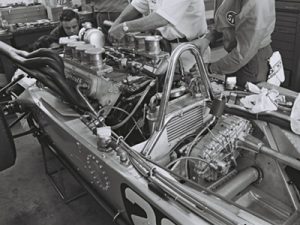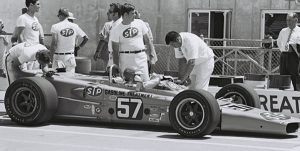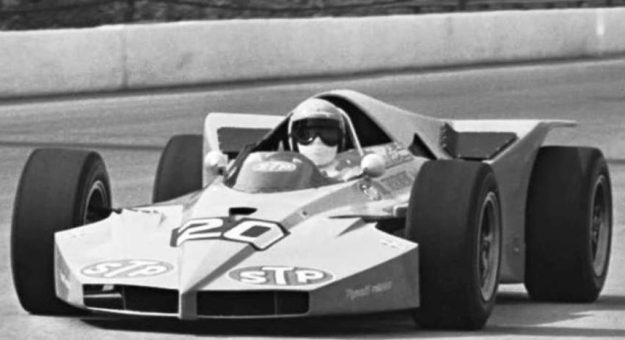In auto racing’s topmost tiers, Plymouth is a brand more often associated with NASCAR than IndyCar.
On Aug. 24, 1969, however, not only did a factory Plymouth-powered car win an Indy car race, it did so at what would become a legendary NASCAR track — Dover (Del.) Motor Speedway.
The story started with a surprise announcement – longtime Chrysler Corp. driver Richard Petty was leaving to drive for Ford in 1969. Petty’s departure left Plymouth with excess money in its racing budget, which officials used to develop a high-rpm, V-8 engine for Indy car racing.
From the drawing board to finished engines took only 90 days, with help from British racing engine designer Harry Westlake. Among his other projects, Westlake developed the V-12 engine with which Dan Gurney won the 1967 Belgium Grand Prix.

For the company’s foray into Indy car racing, Plymouth joined forces with flamboyant car owner Andy Granatelli, whose STP Corp. had sponsored Petty’s Plymouth.
Granatelli assembled three teams for the 1969 season. Famed chief mechanic Clint Brawner headed one team and put together a spectacular season. He and Mario Andretti won the Indianapolis 500 and eight other races en route to securing the national championship.
Granatelli’s brothers, Vince and Joe, were in charge of another team, while accomplished open-wheel race car builder Grant King headed the third.
King, known for his ability to copy any race car from a few photos and some surreptitious-dimension gathering, helped build a Gerhardt chassis, adding some of his own modifications.
This is the car that would ultimately carry the Plymouth engine to success. However, for its initial outing in Hanford, Calif., on April 13, it was powered by an Offy engine. Art Pollard qualified ninth and was running well until tragedy struck on lap 67.
Pollard pitted and during refueling a fire erupted, engulfing the pit. King received severe burns in the inferno. Crew member “Red” Stanton attempted to flee the fire and ran out into pit lane directly in front of Mario Andretti’s car. Andretti’s car struck and killed Stanton.
King repaired the car and went to Indy with it, still using the Offy engine. Carl Williams qualified the car, but it fell out early.
At The Milwaukee Mile a week later, Greg Weld made the 100-miler with the car. But when Pollard, driving for the Granatelli brothers’ team, was eliminated in a 10-car, first-lap melee, he took over the King car. Forced to start last when the race got underway, he charged through the field and won.

Granatelli, who had been experimenting with the Plymouth in one of his Lotuses, realized that King’s modified Gerhardt had much more potential. Consequently, he assigned the Plymouth to King to prep for the USAC Indy car race at Dover, and insisted Pollard be the driver.
The Indy cars drew a massive crowd at Dover. Fans were awed by the electrifying speed they obtained on the 24-degree banking. Bobby Unser grabbed the pole with a track record that stood for 29 years.
Pollard qualified 10th and immediately demonstrated the Plymouth’s pace with a powerful run to the front against both Unsers, Andretti, Gordon Johncock and other USAC luminaries. Pollard took the lead for good on lap 144 and steadily pulled away from Johncock, winning by a 7.48 seconds.
“We are real happy with the engine,” Pollard said in victory lane. “We knew we couldn’t qualify quick because we were short on power. But the Plymouth’s smooth power made it a dream to handle during the race. When the track got oily, I could balance the car easily with the throttle.”
As an interesting aside, Dover earned its nickname, “The Monster Mile,” during the Indy car weekend. Those imposing concrete walls devoured the fragile machines if they tiptoed anywhere near them. Because of safety considerations, Dover wasn’t on the schedule in 1970, and Indy cars didn’t return there until 1998.
Granatelli campaigned the Plymouth in two of his cars for the remainder of the season with varying success. He even shoehorned one into the team’s dirt car. Pollard qualified third with it at the Hoosier Hundred but fell out early. Weld put it on the pole at DuQuoin and Sacramento, but suffered similar fates as Pollard.
When Petty returned to Chrysler for the 1970 NASCAR season, money to further develop the Plymouth Indy car engine evaporated. And so ended Plymouth’s brief sojourn in Indy car racing.
This story appeared in the May 31, 2023 edition of the SPEED SPORT Insider.

